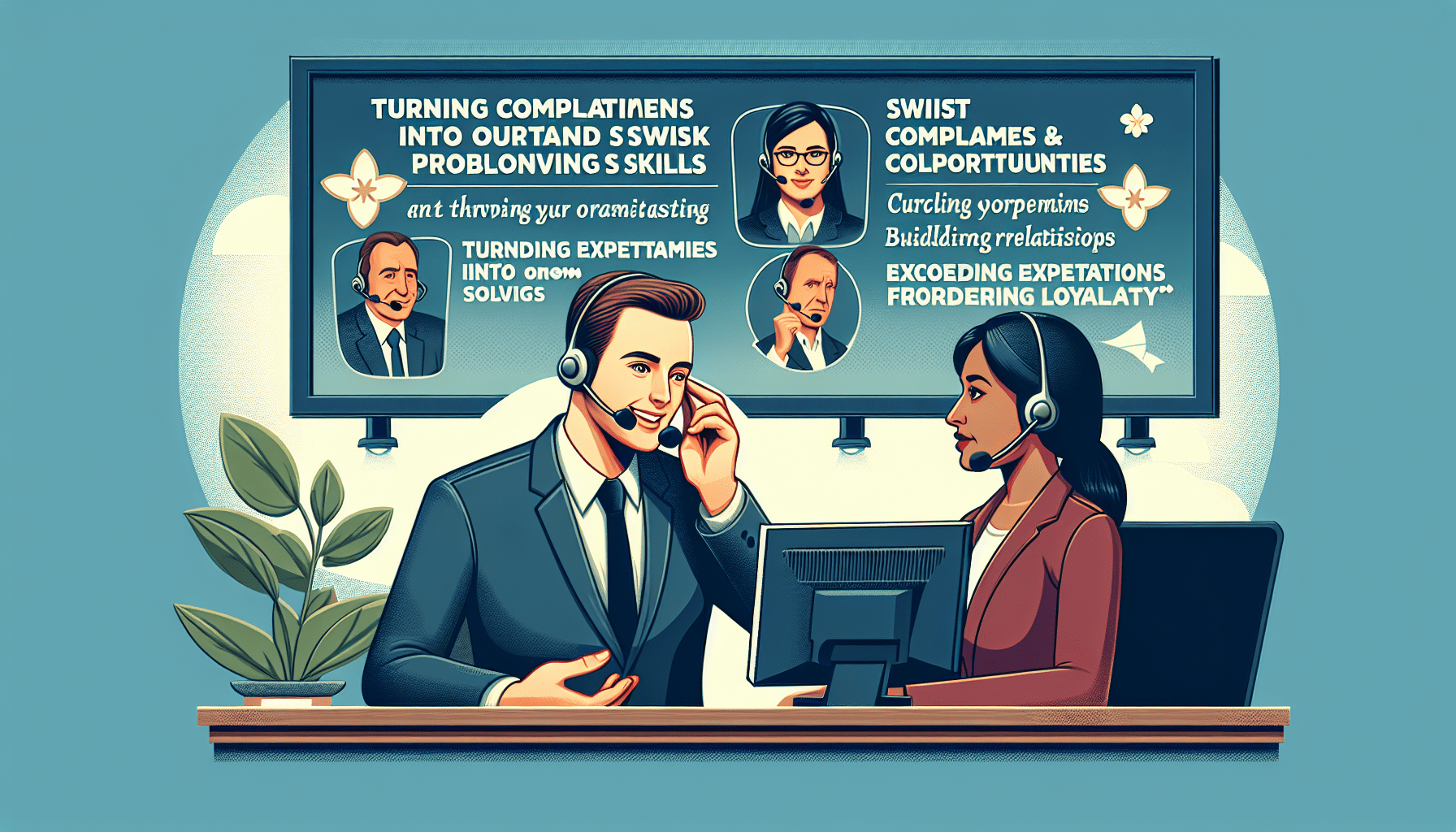You’ve heard it before – the saying that “the customer is always right.” In a world where customer feedback holds significant weight, it’s crucial for businesses to know how to handle customer complaints and ensure customer satisfaction. Understanding how to effectively address customer concerns not only helps resolve issues but also strengthens relationships and builds trust. In this article, we’ll explore some key strategies and best practices for handling customer complaints in a way that leaves your customers feeling heard, valued, and ultimately satisfied with their experience.
Active Listening
When it comes to handling customer complaints and ensuring customer satisfaction, active listening is the key. It involves truly paying attention to the customer’s concerns and giving them the space to vent their frustrations. By actively listening, you show the customer that you value their opinion and are committed to addressing their issues. This creates a foundation of trust and understanding, which is crucial for resolving any problems. So, let’s delve deeper into how to effectively practice active listening.
Pay Attention to the Customer’s Concerns
When a customer reaches out with a complaint, it’s essential to give them your full attention. This means focusing solely on their concerns and avoiding any distractions. Put yourself in their shoes and imagine how it feels to be in their position. By actively listening to their concerns, you demonstrate that their problem matters to you, and you are genuinely invested in finding a solution.
Allow the Customer to Vent Their Frustrations
In many cases, customers just want to be heard. Allowing them to vent their frustrations is a crucial part of the active listening process. It might be tempting to interrupt or defend your company immediately, but it’s important to let the customer express themselves fully. Give them the space to voice their frustrations, and remember that their emotions are valid. Once they have vented, they will be more receptive to finding a resolution.
Demonstrate Empathy and Understanding
Showing empathy and understanding towards the customer is an essential component of active listening. Put yourself in their position and acknowledge their feelings. Use phrases like, “I understand how frustrating this must be for you” or “I can see why this issue is causing you concern.” This lets the customer know that you genuinely care about their experience and are willing to work towards a solution. Empathy goes a long way in defusing tense situations and creating a positive customer service experience.
Prompt Response
Promptly responding to customer complaints is crucial in ensuring customer satisfaction. When customers feel like their concerns are being acknowledged and addressed in a timely manner, it enhances their overall perception of the company. Let’s delve into the key aspects of providing a prompt response to customer complaints.
Acknowledge the Complaint Immediately
The first step to providing a prompt response is acknowledging the customer’s complaint immediately. Whether the complaint is received in person, via phone, email, or through social media, it’s crucial to acknowledge it as soon as possible. This lets the customer know that their concerns have reached the right channels and are being taken seriously. Quick acknowledgment shows that you value their time and are committed to resolving their issue efficiently.
Set Realistic Expectations for Resolution Time
After acknowledging the complaint, it’s important to set realistic expectations for resolving the issue. Depending on the complexity of the problem, some resolutions may take longer than others. Communicate clearly with the customer about the estimated time it will take to address their complaint. This transparency not only manages their expectations but also demonstrates your commitment to resolving their issue thoroughly.
Follow Up to Ensure the Issue was Resolved
Following up with the customer after resolving their complaint is a vital step in the customer service process. It shows that you genuinely care about their satisfaction and want to ensure that the issue has been fully resolved. A simple phone call or email asking if the problem has been resolved to their satisfaction goes a long way in building trust and fostering a positive customer experience.
Apologize Sincerely
Apologizing sincerely is an important aspect of handling customer complaints. It shows that you take responsibility for the matter and genuinely regret the inconvenience caused. Let’s explore how to offer a sincere apology to customers.
Take Responsibility for the Matter
When a customer has a complaint, it’s crucial to take responsibility for the matter at hand. Even if the issue was caused by factors beyond your control, accepting responsibility shows the customer that you are committed to finding a resolution. Avoid deflecting blame or making excuses. Instead, focus on addressing the customer’s concerns and taking ownership of the situation.
Express Genuine Regret for the Inconvenience Caused
While taking responsibility is important, it’s equally vital to express genuine regret for the inconvenience caused. Empathize with the customer and convey your sincere apologies. Using phrases like, “I’m truly sorry for the inconvenience our mistake has caused you” or “We deeply regret the frustration this has caused you” shows that you understand the impact of the issue on their experience and are committed to making things right.
Avoid Making Excuses or Blaming Others
In the process of apologizing, it’s crucial to avoid making excuses or blaming others. Customers do not want to hear why something went wrong; they want an apology and a resolution. Focusing on finding a solution rather than assigning blame helps maintain a positive relationship with the customer. Showing willingness to fix the problem instead of making excuses builds trust and demonstrates your commitment to their satisfaction.
Seek Solutions
When a customer has a complaint, it’s essential to seek solutions that meet their needs and resolve the issue effectively. Taking a proactive approach to finding solutions shows the customer that you are committed to their satisfaction. Let’s explore how to effectively seek solutions to customer complaints.
Ask the Customer How They Would Like the Issue Resolved
When faced with a customer complaint, it’s important to ask the customer how they would like the issue resolved. Some customers might have a specific solution in mind, while others may want guidance on what options are available. By involving the customer in the problem-solving process, you demonstrate a commitment to meeting their needs and finding a resolution that suits them.
Offer Options to Address the Problem
In addition to asking the customer for their preferred resolution, it’s important to offer options to address the problem. Present different solutions or alternatives that can effectively resolve the issue. Providing options allows the customer to choose the solution that best meets their needs and preferences. This empowers the customer and shows your willingness to collaborate in finding a mutually beneficial outcome.
Collaborate with the Customer to Find a Solution
Collaborating with the customer to find a solution is crucial in resolving complaints. Listen to their feedback, ideas, and concerns, and work together towards a resolution. This collaborative effort not only ensures that their needs are met but also strengthens the relationship between the customer and your company. By valuing their input and involving them in decision-making, you demonstrate your commitment to delivering exceptional customer service.
Empower Frontline Staff
Empowering frontline staff is essential in handling customer complaints effectively. By equipping them with the necessary training and authority, you empower them to take ownership of customer issues and provide satisfactory solutions. Let’s delve into the key ways to empower frontline staff.
Train Staff to Handle Complaints Effectively
Effective training is the foundation for empowering frontline staff to handle complaints. Provide comprehensive training on active listening, conflict resolution, and effective communication techniques. Equip them with the knowledge and skills necessary to address customer concerns and provide satisfactory resolutions. Regularly update this training to ensure that staff are equipped with the latest techniques and best practices.
Provide Authority to Make Decisions and Provide Solutions
Empower frontline staff by providing them with the authority to make decisions and provide solutions. When a complaint arises, give them the autonomy to resolve the issue within predefined guidelines or escalate it to the appropriate channels. This empowers staff to act swiftly and efficiently without needing approval at every step. Trusting their judgment not only boosts their confidence but also leads to quicker resolutions for the customer.
Encourage Staff to Take Ownership of Customer Issues
Encourage frontline staff to take ownership of customer issues from start to finish. When a customer complaint is assigned to them, emphasize the importance of seeing it through until a satisfactory resolution has been achieved. This sense of ownership fosters accountability and motivates staff to go above and beyond in delivering exceptional customer service. Acknowledge and recognize their efforts in resolving complex issues, which further reinforces their commitment to customer satisfaction.
Document and Analyze Complaints
Documenting and analyzing customer complaints is crucial in identifying patterns or trends and leveraging data to improve products or services. Let’s explore why this step is essential and how to effectively implement it.
Keep a Record of Customer Complaints and Resolutions
Maintaining a record of customer complaints and resolutions is essential for tracking and analyzing data. Each complaint should be carefully documented, including the details of the issue, the actions taken, and the resolution provided. This helps create a database of customer feedback that can be analyzed for trends and used to drive improvements.
Identify Patterns or Trends in Complaints
Regularly analyzing customer complaint data allows you to identify patterns or trends. Look for recurring issues or themes that emerge from the complaints. For example, if multiple customers have the same complaint about a particular product feature, it indicates the need for improvement or further investigation. Identifying these patterns helps prioritize areas for improvement and inform decision-making processes.
Use Data to Improve Products or Services
Once patterns or trends have been identified, it’s crucial to use the data to drive improvements in products or services. Share the feedback and insights gained from customer complaints with relevant teams or departments. This enables them to make informed decisions and take actions to address the root causes of complaints. By continuously improving products or services based on customer feedback, you demonstrate your commitment to enhancing the customer experience.
Follow Up with the Customer
Following up with the customer after resolving their complaint is an important step in ensuring their satisfaction. This demonstrates that their concerns were taken seriously and provides an opportunity to offer additional assistance or compensation if necessary. Let’s explore how to effectively follow up with customers.
Check if the Issue was Resolved to the Customer’s Satisfaction
Following the resolution of a customer complaint, it’s vital to check if the issue was resolved to the customer’s satisfaction. Reach out to them via phone or email and inquire about their experience. Ask specific questions to ensure that all aspects of their complaint have been adequately addressed. This proactive follow-up shows that you genuinely care about their satisfaction and allows for any potential further action to be taken if required.
Offer Additional Assistance or Compensation if Necessary
During the follow-up communication, it’s essential to offer additional assistance or compensation if necessary. Sometimes, resolving the initial complaint may not completely satisfy a customer’s expectations. By offering additional assistance or compensation, you demonstrate your commitment to going above and beyond to rectify the situation. This gesture can turn a dissatisfied customer into a loyal advocate for your company.
Thank the Customer for Bringing the Issue to Your Attention
Lastly, express your gratitude to the customer for bringing the issue to your attention. By thanking them, you show that their feedback is valued and appreciated. Customer feedback is a valuable source of insight and provides an opportunity for continuous improvement. Through their complaint, they have enabled your company to identify areas for growth and ensure better customer experiences in the future.
Train Employees on Customer Service
Training employees on customer service plays a crucial role in handling complaints effectively and ensuring customer satisfaction. Let’s explore the key components of effective customer service training.
Provide Comprehensive Training on Handling Complaints
Effective customer service training should include comprehensive modules on handling complaints. This training should focus on active listening, conflict resolution, and empathy-building techniques. Equip employees with the skills and knowledge necessary to address customer complaints effectively. Role-playing exercises and case studies can also be used to simulate real-life scenarios and enhance their problem-solving abilities.
Teach Effective Communication and Conflict Resolution Skills
Excellent communication skills are essential for resolving customer complaints. Include training modules that emphasize effective communication techniques, such as using positive language, active listening, and clear and concise responses. Conflict resolution skills are also crucial for managing tense situations and finding mutually beneficial solutions. Provide employees with the tools and strategies necessary to navigate conflicts professionally and empathetically.
Emphasize the Importance of Customer Satisfaction
Throughout the training process, it’s important to emphasize the importance of customer satisfaction. Make it clear that each employee has a role to play in ensuring that every customer’s needs are met and their complaints resolved. By instilling a customer-centric mindset, employees are more likely to take ownership of customer issues and go the extra mile to provide exceptional service.
Use Feedback to Improve
Regularly collecting customer feedback and using it to improve is essential for maintaining customer satisfaction. Let’s explore how to effectively utilize feedback to drive improvements.
Regularly Collect Customer Feedback
Implement strategies to regularly collect customer feedback. This can be done through surveys, suggestion boxes, or online platforms. Providing channels for customers to share their thoughts and experiences allows you to gather valuable insights. It’s important to make the feedback process simple and convenient for the customers to encourage maximum participation.
Use Feedback to Identify Areas for Improvement
Once customer feedback has been collected, thoroughly analyze it to identify areas for improvement. Look for common themes or trends in the feedback that can inform decision-making. Identify any gaps in products, services, or processes that can be addressed to enhance the customer experience. This analytical approach allows you to prioritize areas for improvement based on customer feedback and allocate resources effectively.
Implement Changes Based on Customer Suggestions
Finally, take action on the customer suggestions received. Implement changes to processes, products, or services based on the feedback received. When customers see that their feedback is valued and leads to tangible improvements, it enhances their perception of your company. Regularly communicate the changes made, demonstrating that the company listens to and acts upon customer feedback.
Build a Customer-Centric Culture
Building a customer-centric culture is crucial to ensure that every employee, from frontline staff to senior management, prioritizes customer satisfaction. Let’s explore how to foster a customer-centric culture within your company.
Put the Customer at the Center of Your Business Values
Make customer satisfaction a core value of your business. Ensure that it is reflected in your mission statement and company’s guiding principles. By consciously placing the customer at the center of your business values, you create a culture that places their needs and concerns as a top priority. Reinforce this value through regular communication channels, both internal and external, to demonstrate your commitment to customer satisfaction.
Encourage all Employees to Prioritize Customer Satisfaction
Every employee, regardless of their role within the company, should prioritize customer satisfaction. Encourage all employees to understand their impact on the customer experience and take ownership of resolving customer complaints. Foster a collaborative environment where employees from different departments work together to address customer concerns. By emphasizing the importance of customer satisfaction, you create a culture where exceptional service becomes the norm.
Reward and Recognize Outstanding Customer Service
Rewarding and recognizing outstanding customer service is essential in reinforcing a customer-centric culture. Implement reward and recognition programs that highlight exceptional efforts by employees in resolving customer complaints. Celebrate success stories and share them within the organization to inspire others. By recognizing and rewarding outstanding customer service, you motivate employees to excel in their interactions with customers and maintain high levels of satisfaction.
In conclusion, effectively handling customer complaints and ensuring customer satisfaction requires active listening, prompt responses, sincere apologies, seeking solutions, empowering frontline staff, documenting and analyzing complaints, following up with customers, training employees on customer service, using feedback to improve, and building a customer-centric culture. By implementing these strategies, companies can turn complaints into opportunities to enhance the customer experience and build long-lasting relationships with their customers.




